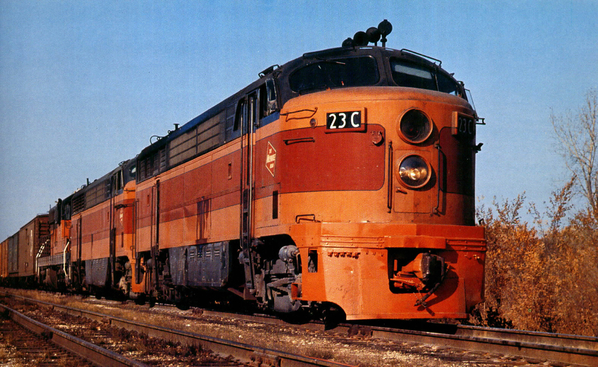This was probably discussed earlier, but I didn't see it. Just in case some missed it (like me), this was in Trains magazine:
Friends of the 261 acquiring Milwaukee Road E9
The E9 was delivered to the Milwaukee Road by EMD in April 1956 as No. 202A. It was part of six sets of A-B-A E9s to be used on Union Pacific’s “Cities” streamliners the Milwaukee began operating between Chicago and Omaha in 1955. All were delivered in UP yellow colors. The numbering sequence for the third set was 202A, 202B, and 202C. In the 1959 Milwaukee Road fleet renumbering the set became 32A, 32B, and 32C. Eventually the units were used on other Milwaukee Road passenger services, such as the Olympian Hiawatha between Chicago and Seattle/Tacoma and the Morning Hiawatha and Afternoon Hiawathabetween Chicago and the Twin Cities. In 1971 the unit began service for Amtrak, officially leaving the Milwaukee Road roster in June 1974. Amtrak had the unit rebuilt at the Milwaukee Shops where it lost its side porthole windows and was renumbered 434. It remained on Amtrak’s roster until 1982.
It was then sold to the Alaska Railroad where it was renumbered 2402. It toiled in the 49th state until 1986 when it was purchased by Wisconsin’s Northern Rail Car Leasing and numbered 10C. Northern Railcar founded Scenic Rail Dining, which between 1987 and 1990 operated a high-end dinner train out of North Milwaukee, Wis., on a portion of the former Milwaukee Road to Horicon, Wis., owned by the Wisconsin & Southern Railroad. In 1988, Northern Rail Car, owned by William Gardner purchased the Wisconsin & Southern. When the dinner train was discontinued in 1990, Wisconsin & Southern retained the unit for its business train. The unit was rebuilt, including restoration of its porthole windows, and eventually renumbered 101 when an E9B was leased from Illinois Railway Museum and rebuilt to operate with 10C and Wisconsin & Southern’s other E9A, 10A, a former UP unit.
After Watco acquired Wisconsin & Southern in 2011, it sold the 10A to Iowa Pacific and the E9B was returned to the Illinois Railway Museum. The 10C was retained but saw minimal use. According to the Friends, the railroad hoped to see the locomotive go to a good home that would continue to use it and keep it in good working order, not rusting away in a museum or going to scrap. Longtime Friends of the 261 members Robert Schroeder and Mary Walters provided key support for the acquisition.
Friends of the 261 President and Chief Operating Officer Steve Sandberg says the E unit will be a great addition to the organization. “To have an original Milwaukee Road E-unit in our fleet is just amazing,” he says. “We can use this unit both to supplement 261 operations and allow us to run trips where it might be too expensive to operate 261. It will open up a lot of new markets for us. Of course, an E9, like 261, is an attraction itself.”
Like No. 261, the locomotive has a Sandberg family connection. It was once operated by Sandberg’s grandfather, Frank E. Sandberg Sr. The elder Sandberg was a Milwaukee Road engineer on the River Division operating passenger trains between Minneapolis and La Crosse, Wis. Steve Sandberg’s father, the late Frank E. Sandberg Jr. frequently rode with his father on passenger runs, and after Steve was born he brought his son along as well.
“It’s a pretty safe bet I rode this unit as a boy,” Steve Sandberg says.
When Sandberg Sr. retired after 52 years of service in 1970, No. 32A was the lead locomotive on his last run, the Morning Hiawatha from La Crosse to Minneapolis. On arrival at the Minneapolis depot his family greeted him as he stepped from the cab for the last time, including his young grandson.
Sandberg says the unit needs minor mechanical work, and then will be repainted. But it won’t be painted Union Pacific yellow, the scheme it wore in Milwaukee Road days. The Friends fleet is all painted in the orange and maroon colors used by the Milwaukee until it began operating the UP streamliners, and having a yellow unit wouldn’t match the train. After World War II the Milwaukee Road used a variety of paint schemes on its passenger diesels, and Sandberg says he is studying which one might be appropriate to use in lieu of yellow.
Friends of the 261 is asking for donations to go toward repainting the locomotive and for mechanical work. The organization hopes to have the unit ready to pull trips sometime in 2019.












